Creating a NEW Project View via Pull Operation - OnePager Pro for Version 5.3
Contents
Creating a NEW Project View via Pull Operation - OnePager Pro for Version 5.3 (P53-7_13_1-12052015)
The purpose of these articles is to acquaint you with the new “Pull” features of OnePager Pro and Express Versions 5.3. There are eight (8) articles in this series, four (4) providing examples of the “Pull” feature for OnePager Pro Desktop and Add-in and four (4) for OnePager Express Desktop and Add-in. Please see the links at the end of this article to access other articles in the series.
This article shows you how to use the “Pull” feature when you need to create a NEW project view such as when you want to generate a second project views from different source files or from the same slightly modified source files.
What is a Pull Operation?
Before we get started with the example, this is a good point to describe the “Pull” Operation. A “Pull” Operation is performed when you start using OnePager from the Project View Editor. That is, you already have OnePager launched and running and the Project View Editor window is blank. Alternatively, a “Push” Operation begins when you launch OnePager from the desktop or from Microsoft Project and perform the creation of a NEW project view, UPDATE a project view, or OPEN an existing project view from the “OnePager Pro Start” form.
We added the “Pull” Operation because we found that our users were often creating a project view, finding something in the source file that they needed to change, going back to the source file, making the change and then re-launching OnePager to replace the project view.
The “Pull” Operation lets you launch OnePager once, create your project view, and, if you need to make a source file change, you may go back to the source file and do that. When you’ve updated the source file, you need only go back to OnePager and through the new “Data” tab quickly “pull” in the amended source file, update your project view, and continue.
You’ll see this more in play when you read the articles REPLACING a Snapshot via Pull Operation - OnePager Pro for Version 5.3 and ADDING a Snapshot via Pull Operation - OnePager Pro for Version 5.3.
In the “Pull’ Operation as described above, OnePager “pulls” the data into the Project View Editor whereas in a “Push” Operation Microsoft Project provides or “pushes” the data to OnePager Pro.
The example below will illustrate a “Pull” Operation when creating a NEW project view.
Example
1) Let’s suppose you have a Microsoft Project plan that you want to present to two different audiences – Your Project Management Office (PMO) and your customer. However, before the presentation you want to quickly examine the two project views made by OnePager side-by-side.
2) In preparation, you “flag” the rows to be shown to the PMO using Microsoft Project’s “Flag20” column and put a “Yes” in the appropriate rows of the Microsoft Project plan. You also decide to use “Flag10” to show those rows that you want to show in your presentation to the customer. You insert both the “Flag20” and “Flag10” columns into the plan as shown below:

Prepare First Project View
3) We are going to illustrate the “Pull” feature in two ways. First, we’ll set up the OnePager Pro desktop application to “pull in” the Microsoft Project plan using the “Flag20” flag column shown above.
4) Launch OnePager Pro from the desktop icon and when the “OnePager Pro Start” form appears just click the “Close” button. This action will take you to the “File” tab as shown below:
5) Now, click the “New…” button in the “File” tab list. This action will bring up the Project View Editor screen with the “OnePager choices” form showing. Next, click the “Select” button which brings down a menu from which we will select the second entry which is the Microsoft Project plan we are using in this example as shown below:
6) When you click on the second entry in the drop down menu as shown above, OnePager Pro will expand the “OnePager choices” form so you can confirm the remainder of the settings before OnePager generates the project view. This is shown below:
7) After the settings are confirmed in the above form we will be asking OnePager to generate a project view with the Title shown above, using the indicated “flag” column and designating the snapshot with the date shown. When you click the “Create new project view” button OnePager will create the following project view:
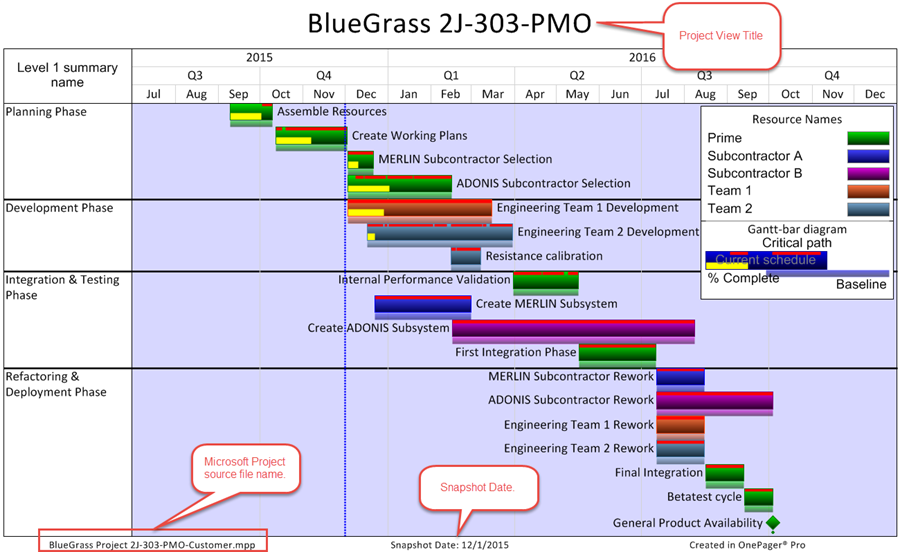
8) The above portion of the example is a strict usage of the “Pull” feature to create a new project view. Since we are using the desktop application of OnePager for this example it was not necessary to launch Microsoft Project first. As long as you’ve properly prepared your Microsoft Project plan source file just launching OnePager Pro from the desktop icon is basically all that is necessary to utilize the new “Pull” feature.
9) At this point it is recommended that you save this first project view for access later.
Prepare Second Project View
10) With the above project view saved yet visible in the Project View Editor window, again click on the “File” tab on the OnePager ribbon and then click the “New…” tab on the page that appears:
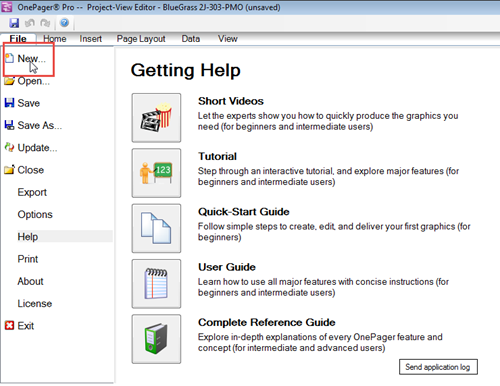
11) When you click the “New…” button as shown above, OnePager will display another “OnePager choices” form which you will now use to create the project view for the customer by giving the new project view a new name, specifying that the “flag” column to be used is “Flag10”, and specifying the appropriate snapshot date as shown in the sequence below:
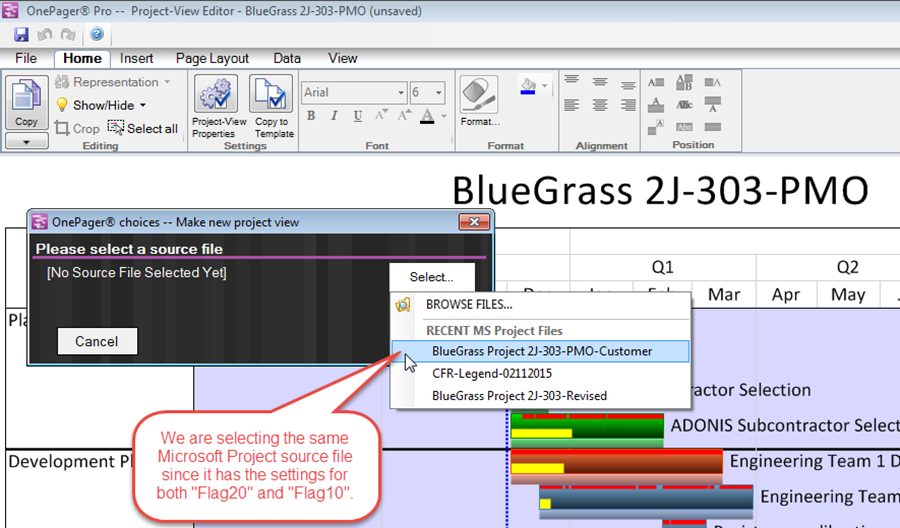
12) When the file is selected the “OnePager choices” form will expand as before and again provide you with the ability to uniquely name the new project view, specify the “flag” field to use, and specify the snapshot date as we have done in the illustration below:
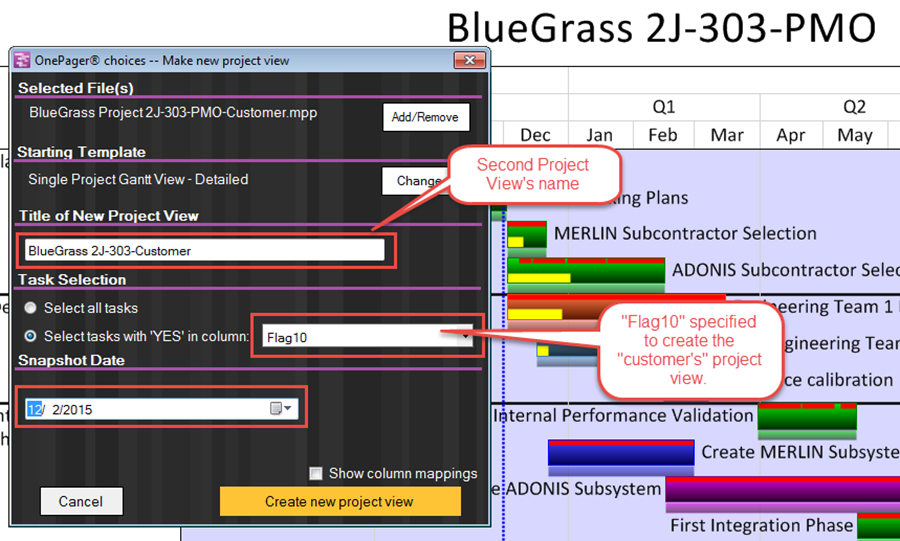
13) With the new settings confirmed in the “OnePager choices” form, click the “Create new project view” and OnePager will use your new settings to create the second project view and display it as shown below:
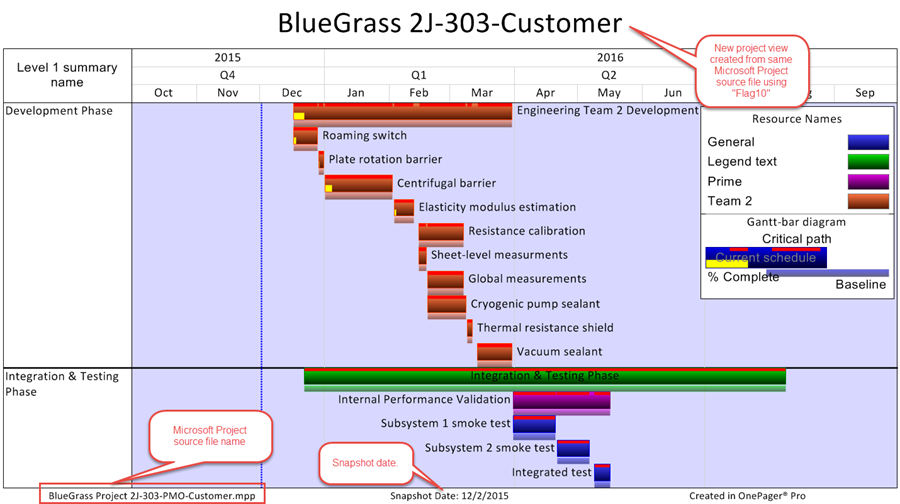
14) In this example we used the “Pull” Operation twice to create two project views from the same Microsoft Project plan source file but using different “flag” columns. Now that the second project view is created, we recommend that it too be saved for future access.
Compare Results, Edit, Copy to PowerPoint
15) Once you are satisfied with your project view you may save them, copy them into PowerPoint presentations, or share time in other ways.
16) The “Pull” Operation is an easy, fast, and convenient way to create multiple project views which will make you more efficient.
Related Links:
Creating a NEW Project View via Pull Operation - OnePager Express for Version 5.3 7.13.2-53
REPLACING a Snapshot via Pull Operation - OnePager Pro for Version 5.3 7.14.1-53
REPLACING a Snapshot via Pull Operation - OnePager Express for Version 5.3 7.14.2-53
ADDING a Snapshot via Pull Operation - OnePager Pro for Version 5.3 7.15.1-53
ADDING a Snapshot via Pull Operation - OnePager Express for Version 5.3 7.15.2-53
Custom REPLACING a Snapshot via Pull Operation - OnePager Pro for Version 5.3 7.16.1-53
Custom REPLACING a Snapshot via Pull Operation - OnePager Express for Version 5.3 7.16.2-53
(7.13.1-53)